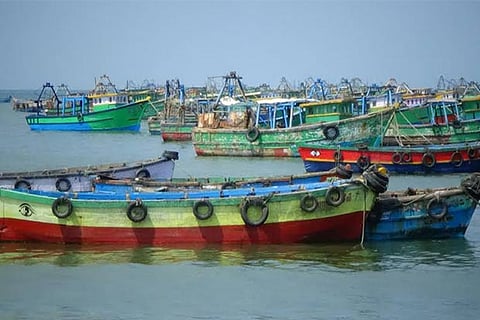

Chennai
While the ban ensures fish species propagation which otherwise would be affected by tremors caused by boat engines, the common complaint of mechanised boat owners is that the ban should be extended to country boats which have now started using outboard engines.
Country boats are exempted from the ban as they either use very low horse power engines or are motor-less. But with country boats now getting bigger, they have to use higher power HP engines for faster movement in the sea. Mechanised vessel fishermen wonder why such boats alone are allowed during the ban period, when their engines will also affect fish propagation.
Fisheries department sources say that the 13 coastal districts account for 50, 777 boats which include mechanised vessels, wooden and FRP (fibre reinforced plastic) country boats. The usual ploy is for mechanised vessel crew members to work in country boats during the ban. As their daily earnings depend on the vagaries of the sea, the ban period affects their families despite the state government giving Rs.2000 per family to sustain them during the ban.
The government, fisheries department sources said, dispersed Rs.32 crores to 1.60 lakh fishermen’s families during the ban period in 2013-14 for which figures are available. But fishermen’s grievance is that the first to benefit are those involved in fishing indirectly like driving fish carts or providing ancillary services for fishing boats.
As the amount is dispersed in instalments and also given when fishermen return to the sea after the ban, it creates problems for fishermen as they do not know exactly when they will receive the amount in their bank accounts.
Fishermen from Thanjavur, Pudukottai and Ramanathapuram districts say that their families are given Rs.250 per day when they are nabbed by the Sri Lankan navy for encroaching into the island nation’s waters. Fisherman Edison said, “as the ban period is akin to our losing working days, the state government could consider giving us Rs.250 during the ban period.”
Another sop provided by the state government is Rs.4000 through the fishermen’s co-operatives for which a member has to pay an amount every month. Fishermen are given the amount near Deepavali to enable them to celebrate the festival without any financial crunch, sources said. As their personal presence is a must during disbursement of money to their bank accounts, fishermen say they are affected especially if it is a day when they have to go to sea.
To ensure that their families are not affected monetarily during the ban period and to assure that they have money when they restart fishing, many fishermen migrate to other states like Karnataka and Kerala where their services are in demand. Fishermen have to reach Mangalore before the season starts to register themselves with the fisheries officials there if they are to participate in fishing activities with their Karnataka counterparts.
Another favourite area is Kochi where they are assured of work due to the many marine product export companies there. But what worries mechanised vessel owners is that when they return to sea after the ban, they have to undertake a prolonged search for fish as country boats which have slowly started using pair/purse seine nets would have emptied an area of fish species.
For Rameswaram fishermen, the ongoing Sri Lankan issue restricts them from fishing near Katchatheevu — where they can be assured of a good catch — and with the Tamil Nadu government’s Tuna long liner scheme not finding much takers due to the heavy investment involved, the time seems right for the state fisheries department to extend its mother carrier vessel scheme to this area in addition to Kanyakumari district where it is to be started soon.
A problem exclusive to Rameswaram is that being a pilgrimage town, most people are involved in tourism related industry including trade and services. The services sector increased from 70% in 1971 to 98.78% in 2001, while agriculture diminished from 23% to 0.13% in the same period.
The area is industrially backward as there is no demarcation for industries due to pilgrim sanctity and the area’s ecologically fragile geography. It is not so with other districts which are more developed, specially Thanjavur, Tiruvarur and Pudukottai districts which rely on agriculture, Chennai, Kanchipuram, Tiruvallur and other districts which have various industries.
Fact File
Tamil Nadu’s 13 coastal districts have: 50, 777 boats.
Mechanised vessels – 5, 596 Country boats (wooden) – 7511
Country boats (FRP) – 8002
Catamarans (Wooden) – 19, 959
Catamarans (FRP) - 9709
Visit news.dtnext.in to explore our interactive epaper!
Download the DT Next app for more exciting features!
Click here for iOS
Click here for Android